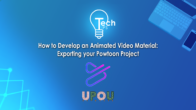Tech Tips 22: Exploring Powtoon Studio Interface
Hey there, it’s time for another episode of this Tech Tips series.
In this Tech Tips series, we are diving into the exciting world of PowToon.
This episode is part of the Animation 101 Tech Tips series.
In the previous episode, we explored PowToon workspace.
In this video, we now explore the PowToon Studio interface. Are you ready? Let’s start!
Creating a Project in Powtoon.
For this series, we will use a blank canvas to start our project.
To do this, click on the blank button in the menu bar located below the Import button.
Once you click it, you can now choose your preferred size and orientation for your animated video.
For this video, we will be using the horizontal option.
A new tab will appear where you will be asked to choose a look or style for your video.
In this case, we will choose Animation Look. You will then be directed to the studio.
In case you change your mind about the style of your video, you can still change your video content look.
To do this, just click on the drop-down button on the top right corner of your screen and select the look you want to have for your video.
Exploring Powtoon Studio.
The Powtoon Studio is divided into four parts. the slide panel, stage, timeline, and elements.
On the left corner, you can see the slide panel where the slides are displayed in a thumbnail view.
Found in the center is the stage, or what we can also refer to as the canvas, where you build your scenes, slides, or sequences.
Below the stage is the timeline, which is the visual representation of the timing of all the elements you inserted on the slide.
On the right corner, you can see the elements such as scenes, background, text, characters, props, shapes, and specials.
These are the assets already available in the Powtoon Studio, which you can work on.
You can also upload images, videos, and audio to customize your animation.
And there you have it. You can now start creating your animated video in Powtoon.
In the next Tech Tips episode, we will learn how to add assets on your canvas, starting with the background. See you there!





























